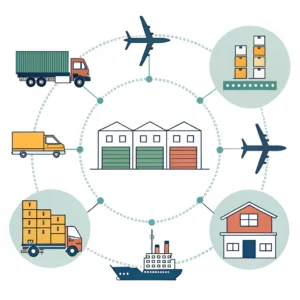Shipping from China to the USA by sea requires careful planning, compliance with international shipping regulations, and working with a trusted freight forwarder1 to ensure the timely and secure arrival of your goods.
When shipping by sea, your freight journey involves selecting the right container load option, understanding shipping routes, preparing accurate documentation, and monitoring your shipment through each stage of the transit. This guide explains the step-by-step process for ocean shipping between China and the USA and provides insights into cost factors, documentation, and industry best practices.
Maritime shipping remains one of the most cost-efficient methods for transporting large volumes of goods internationally. When shipping from China to the USA, there are two main container options:
- Full Container Load (FCL)2: This option is ideal when you have enough cargo to fill an entire container. It offers better security, no cargo mixing, and easier handling.
- Less Than Container Load (LCL)3: This alternative allows you to share container space with other shippers if your cargo volume is lower. While cost-effective for smaller shipments, LCL may lead to more cargo handling and slightly longer transit times.
Choosing between FCL and LCL depends on the volume of your shipment, cost considerations, and how quickly you need your goods delivered.
Shipping from China to the USA encompasses several critical stages. Below is a structured overview of the process:
- Cargo Evaluation: Determine whether your shipments qualify as FCL or LCL based on volume and weight.
- Freight Forwarder Selection: Choose an experienced freight forwarder, preferably one with proven expertise in China-USA routes. A reliable partner such as Shenzhen King-Hor Supply Chain Co.,Ltd can provide door-to-door services, ensuring seamless coordination.
- Quotation and Cost Estimation: Request detailed quotes which typically include base freight charges, fuel surcharges, port fees, and any additional services (documentation, warehousing, inland trucking).
- Commercial Invoice: This should detail the description, value, and quantity of your goods.
- Bill of Lading (B/L)4: A vital transport document that governs the cargo's movement.
- Packing List: Contains specifics on how goods are packed.
- Export/Import Licenses: Depending on the nature of your goods, appropriate licenses or permits may be required.
- Customs Documentation: Ensure compliance with both Chinese export procedures and U.S. import regulations.
- Booking with Carrier: Your freight forwarder will book a container space on a shipping line that best suits your revenue and time considerations.
- Container Loading: Goods are loaded into the container at your designated warehouse in China. Professional packing ensures goods are secure during transit and minimizes damage.
- Inspection and Sealing: Once loaded, the container is sealed and inspected before departure, providing additional security for your cargo.
- Direct vs. Indirect Routes: There are direct routes from China to the USA, primarily via the Pacific Ocean leading to the West Coast. Alternatively, indirect routes may navigate across the South China Sea, through the Indian Ocean, and even traverse the Atlantic Ocean to reach the East Coast.
- Transit Times: Depending on the route, transit times can vary between 15 to 30 days. Booking with a reputable carrier helps maintain reliable schedules.
- Port Operations: Upon arrival at a U.S. port, your container is transferred for customs clearance.
- Customs Broker: A licensed customs broker works with your freight forwarder to handle detailed inspections and ensure all documents are correct.
- Delivery Final Mile: After clearance, your freight is transported via inland trucking to its final destination.
It is vital to prepare a complete set of documents to avoid delays. Below is a brief table summarizing critical documents required for shipping from China to the USA:
| Document | Purpose | Notes |
|---|---|---|
| Commercial Invoice | Provides shipment value and description | Must include accurate pricing for customs |
| Bill of Lading (B/L) | Serves as a contract between shipper and carrier | Contains shipment details and final destination |
| Packing List | Lists cargo's packaging details | Necessary for customs and logistics |
| Export/Import Licenses | Compliance with regulations | Applicable for restricted items |
| Certificate of Origin | Verifies production country | May be required depending on cargo type |
Shipping costs can vary based on several factors. A simplified breakdown is as follows:
- Container Size and Type: A standard 20-foot container may be priced between $2,000 and $3,500 based on market conditions.
- Fuel Surcharges: Fuel price fluctuations can affect overall freight charges.
- Port Fees and Handling: Charges incurred at both the loading and unloading ports.
- Insurance: Optional yet recommended coverage against loss or damage.
- Additional Services: Costs for inland trucking, warehousing, and customs brokerage.
- Partner with a Trusted Freight Forwarder: Select a company with an established track record in China-USA maritime shipping. A dependable partner will simplify the process, from booking to last-mile delivery.
- Timely and Accurate Documentation: Ensure every document is reviewed and submitted on time to avoid potential customs delays.
- Monitor Your Shipment Actively: Utilize tracking systems provided by your freight forwarder to keep abreast of your container’s progress.
- Plan for Contingencies: Unexpected delays due to weather conditions, port congestions, or regulatory changes may occur. Always add buffer times in your logistical planning.
Determining the best shipping route is crucial for timely and efficient transit. There are primarily two types of routing:
-
Direct Routes:
- Pacific Ocean Route: This is the most straightforward route, where containers travel directly across the Pacific to major U.S. West Coast ports like Los Angeles, Long Beach, or Oakland.
- Advantages: Reduced transit times, fewer handling points.
- Challenges: Limited to west coast destinations, potential congestions at busy ports.
-
Indirect Routes:
- Multi-Stop Routes: These often involve vessels moving through multiple ports. For instance, shipments may traverse the South China Sea, then cross the Indian Ocean and Suez Canal before reaching East Coast ports.
- Advantages: Flexibility in reaching various U.S. destinations.
- Challenges: Longer transit times and increased complexity with multiple handling stages.
The choice of route depends largely on your final delivery location and schedule. Strategic planning and route optimization with your freight forwarder are recommended to meet your shipping objectives.
A competent freight forwarder is pivotal for a smooth shipping process. Here are some benefits of working with a specialized freight forwarding company:
- Consolidated Services: Companies like Shenzhen King-Hor Supply Chain Co.,Ltd offer a full suite of services from ocean shipping to inland trucking, customs brokerage, and global supply chain management.
- Expertise in Regulations: Their industry expertise simplifies handling complex customs regulations, ensuring compliance with U.S. and Chinese regulations.
- Flexible Container Solutions: They provide both FCL and LCL solutions, depending on shipment volume and budget constraints.
- Transparent Pricing and Tracking: With upfront quotations and state-of-the-art tracking systems, you can monitor your shipment and manage shipping costs effectively.
By selecting a trusted forwarding partner, you not only get professional handling of your cargo but also benefit from tailored logistics strategies that align with your business goals.
To summarize, shipping from China to the USA by sea involves clear planning and following structured steps:
- Evaluate Your Cargo Volume: Decide whether FCL or LCL best meets your needs.
- Prepare Accurate Documentation: Ensure all shipping documents are complete to avoid delays in customs.
- Select a Trusted Freight Forwarder: A capable partner can navigate challenges and provide comprehensive solutions.
- Consider Shipping Routes: Choose the route that best fits your timeline and destination, whether a direct Pacific route for West Coast delivery or an indirect route for East Coast requirements.
- Monitor and Adjust: Keep track of your shipment and remain proactive in managing any issues that may arise.
These actionable insights aim to empower logistics managers and supply chain professionals to make informed decisions, reducing the risk of delays or disruptions and achieving cost-efficient shipping from China to the USA.
How much is sea shipping from China to USA?
A standard 20-foot container shipped by sea from China to the USA can cost roughly between $2,000 and $3,500. This cost is influenced by various factors such as fuel surcharges, port fees, and the nature of the cargo.
What is the sea route from China to USA?
Sea routes from China to the USA can be classified into direct and indirect paths. The direct route involves crossing the Pacific Ocean to reach U.S. West Coast ports. In contrast, indirect routes may cross the South China Sea, pass through the Indian Ocean, and navigate vias like the Suez Canal to eventually arrive at U.S. East Coast terminals.
What is the best way to ship from China to US?
For sea shipping, the best approach is to work with a reputable freight forwarder experienced in managing all aspects of the shipping process, from container booking and documentation to customs clearance and final inland delivery. This ensures cost efficiency, regulatory compliance, and reliable transit of your goods.
-
freight forwarder: Read this article to understand how freight forwarders coordinate logistics, manage shipping documentation, and streamline international cargo movement. ↩
-
Full Container Load (FCL): Click here to learn more about FCL, its benefits, and when it is the best choice for large shipments. ↩
-
Less Than Container Load (LCL): Discover the details of LCL shipping, including cost benefits and the potential challenges of sharing container space. ↩
-
Bill of Lading (B/L): This article explains the role of a Bill of Lading in international shipping, its legal significance, and why it is crucial for cargo transport. ↩












